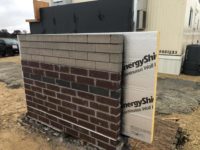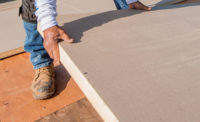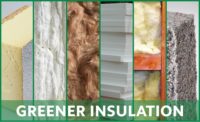The Ancient Greeks believed five basic elements made-up the Universe: earth, water, air, fire and aether (the so-called “classical elements”). And, coincidentally, the Ancient Greeks were among the first cultures to build masonry cavity walls.
It turns out that masonry cavity walls help defend buildings against several of the classical elements: water, air and fire. As the Masonry Advisory Council (MAC) explains:
“Today, masonry cavity walls are used extensively throughout the United States in all types of buildings. The primary reasons for their popularity are superior resistance to rain penetration, excellent thermal properties, excellent resistance to sound transmission and high resistance to fire.”
A Closer Look at Masonry Cavity Walls
In case you’re not familiar with masonry cavity walls, they consist of two separate masonry layers (“wythes”) with an air space between them. Corrosion-resistant wall ties connect the two wythes, which can be built of brick, structural clay tile, concrete, concrete blocks or stone. For best performance, insulation is installed on the inner wythe’s outside face. An un-obstructed air space must be maintained in the cavity to allow any moisture that penetrates the outer wythe to drain down its inside face to flashings that channel it back out of the wall via weep holes.
This system provides exceptional moisture defense for the overall wall assembly by keeping moisture away from the inner wythe. Because the air space is crucial for managing moisture, the TMS 402-11 Building Code Requirements for Masonry Structures (section 6.2.2.8.2) calls for:
“A 4-½ in. (114-mm) maximum distance between the inside face of the veneer and the outside face of the masonry or concrete backing shall be specified. A 1-in (25.4-mm) minimum air space shall be specified.”
In addition to exceptional moisture management, the multi-layer wall configuration aids in thermal performance. “Both wythes act as a heat reservoir, positively affecting heating and cooling modes,” notes the MAC. The two wythes with air space also dampens sound, for a quieter indoor environment. MAC also notes masonry cavity walls have “excellent fire resistance,” as shown in testing, and that “all cavity walls have a fire rating of 4 hours or greater.”
Specifying Insulation in Masonry Cavity Walls
Various types of insulation have been used in masonry cavity walls: rigid foam boards, spray polyurethane foam (SPF) and mineral wool. Among these, two rigid foams predominate: extruded polystyrene (XPS) and polyisocyanurate (polyiso).
Let’s look more closely at polyiso’s thermal and moisture performance, along with other advantages, including fire performance and resistance to solvents.
Thermal and Moisture Performance
One of the main benefits polyiso can provide in a masonry cavity wall is meeting today’s higher code mandated R-values without increasing insulation thickness to a point where it minimizes the airspace or forces expansion of the cavity to accommodate the insulation. Polyiso offers increased R-value per inch vs. mineral fiber, XPS or EPS insulation options, so is particularly well-suited for masonry cavity walls, given the 1-inch minimum air space requirement. This enables a thinner overall wall assembly than is possible with other insulations, thereby lowering material and labor costs for wall construction.
Additionally, as a closed-cell insulation, polyiso resists moisture intrusion. Products with foil facers also enhance water resistance. “The foil face on the polyiso insulation is an impermeable material, which enhances long-term thermal performance,” notes the Polyiso Insulation Manufacturers Association (PIMA) in its Technical Bulletin 401. This dual moisture protection of the facers and closed cells is important, as an insulation’s R-value decreases when it is moistened.
Fire Performance
The chemical bonds within polyiso provide a high level of fire resistance. Unlike other rigid foam insulations, polyiso does not melt when exposed to fire, but instead develops a protective char. In light of this fire performance, polyiso manufacturers have developed products that pass NFPA 285, Standard Fire Test Method for Evaluation of Fire Propagation Characteristics of Exterior Non-Load-Bearing Wall Assemblies Containing Combustible Components, in numerous wall assemblies.
Additionally, due to polyiso’s fire performance characteristics, special header details in windows and openings are not required to pass this test. Further, if a building has combustible claddings in some areas and brick in others, XPS doesn’t have approved NFPA 285 assemblies, while polyiso does, so it doesn’t require changing materials in different parts of the building.
Resistance to Solvents
As PIMA notes, cavity wall designs often include materials with petroleum-based solvents—such as adhesives, preservative coatings and waterproofing. Such solvents can degrade other rigid foam insulations, but do not affect polyiso.
Example Project: Manor High School
The fast-growing Austin, Texas, metro area added nearly 300,000 people from 2010 to 2015, and the region remains one of the top 10 for growth in the U.S. The Manor Independent School District in suburban Manor, Texas, experiences the Austin region’s growth impacts first hand as it prepares to double its student count in the next five years from 9,000 to 18,000 students, reports KXAN TV.
To serve the larger student body, the district in 2017 added a new Manor High School on an adjacent campus to supplement the existing high school.
Designed by Perkins + Will, the new school building has cavity walls comprised of rock masonry, metal cladding, and metal stud framing with exterior gypsum. One challenge the architects faced was providing continuous insulation within the cavity, while also meeting fire requirements under NFPA 285.
“The project was originally spec’d with XPS insulation, but swapping that out for Hunter Panels Xci CG polyiso improved the thermal performance, and met NFPA 285,” says Darren Butler, president of NVLP Materials. “The price did not change when switching to Xci CG for the contractor and everyone was happy and code compliant.”
Conclusion
In addition to building with masonry cavity walls and organizing the physical world into their five “classical elements,” the Ancient Greeks produced many of history’s best-known philosophers. One of them, Socrates, said “The only true wisdom is knowing you know nothing.” That might not always be true for highly educated and experienced architects and engineers, but is useful to keep in mind when designing buildings. For example, many building professionals know polyiso as a roof insulation, but considering it for use in walls—including masonry cavity walls—can provide many benefits as noted in this article.





